Global marketing 2 qwertyuiopasdfghjklzxcvbnmqwertyuiopasdfghjklzxcvbnmqwertyuiopasdfghjklzxcvbnmqwertyuiopasdfghjklzxcvbnmqwertyuiopasdfghjklzxcvbnmqwertyuiopasdghjklzxcvvbnmqwertyuiopasdghj
VerifiedAdded on 2022/10/17
|16
|3466
|145
Assignment
AI Summary
Global marketing 2 qwertyuiopasdfghjklzxcvbnmqwertyuiopasdfghxcxcdfdfghxcdfghxcdfghxcdfghxcdfghxcdfghxcdfghxcdfghxcdfghxcdfghxcdfghxcdfghxcdfghxcdfghxcdfghxcdfghxcdfghxcdfghxcdfghxcdfghxcdfghxcdfghxcdfghxcdfghxc
Contribute Materials
Your contribution can guide someone’s learning journey. Share your
documents today.
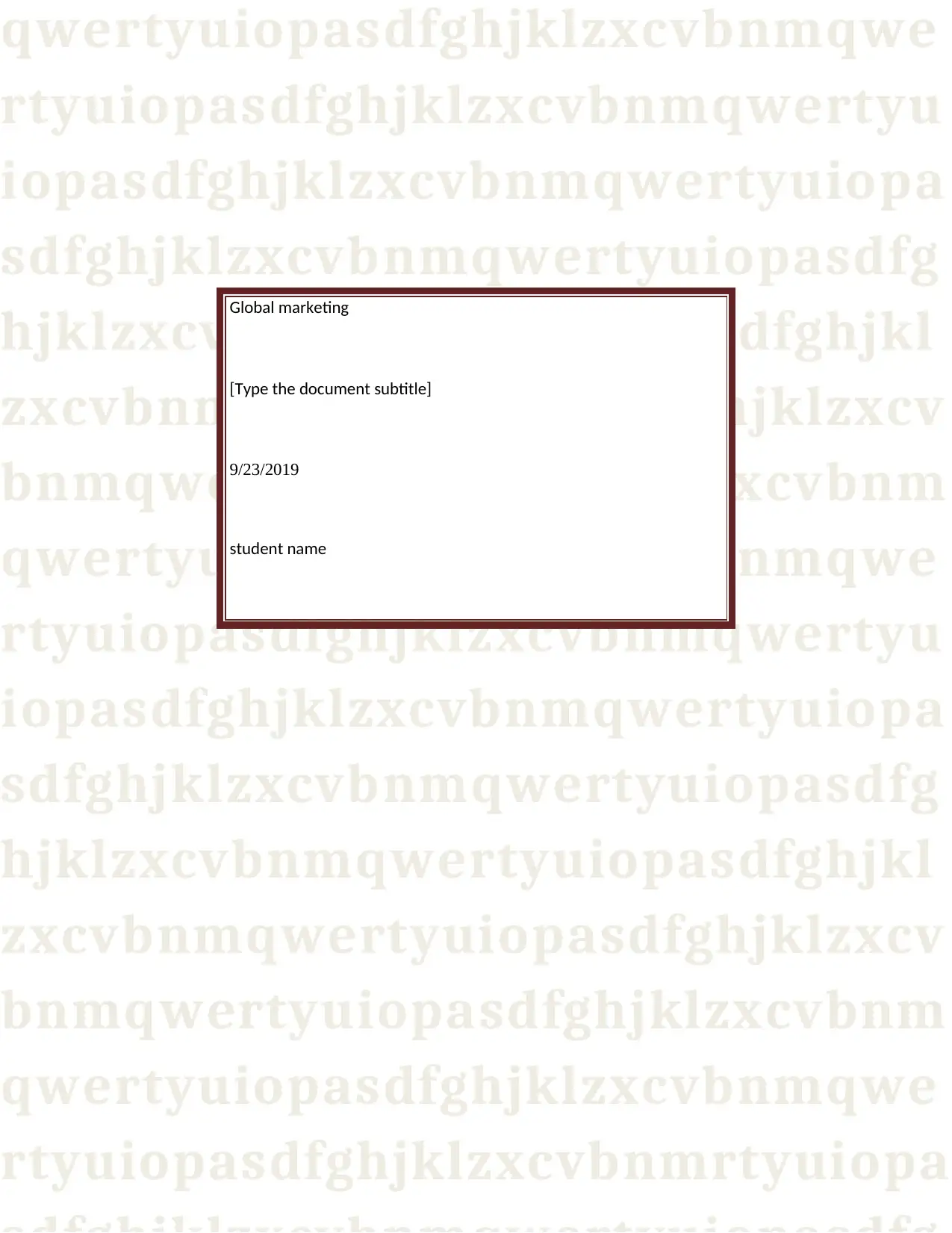
qwertyuiopasdfghjklzxcvbnmqwe
rtyuiopasdfghjklzxcvbnmqwertyu
iopasdfghjklzxcvbnmqwertyuiopa
sdfghjklzxcvbnmqwertyuiopasdfg
hjklzxcvbnmqwertyuiopasdfghjkl
zxcvbnmqwertyuiopasdfghjklzxcv
bnmqwertyuiopasdfghjklzxcvbnm
qwertyuiopasdfghjklzxcvbnmqwe
rtyuiopasdfghjklzxcvbnmqwertyu
iopasdfghjklzxcvbnmqwertyuiopa
sdfghjklzxcvbnmqwertyuiopasdfg
hjklzxcvbnmqwertyuiopasdfghjkl
zxcvbnmqwertyuiopasdfghjklzxcv
bnmqwertyuiopasdfghjklzxcvbnm
qwertyuiopasdfghjklzxcvbnmqwe
rtyuiopasdfghjklzxcvbnmrtyuiopa
Global marketing
[Type the document subtitle]
9/23/2019
student name
rtyuiopasdfghjklzxcvbnmqwertyu
iopasdfghjklzxcvbnmqwertyuiopa
sdfghjklzxcvbnmqwertyuiopasdfg
hjklzxcvbnmqwertyuiopasdfghjkl
zxcvbnmqwertyuiopasdfghjklzxcv
bnmqwertyuiopasdfghjklzxcvbnm
qwertyuiopasdfghjklzxcvbnmqwe
rtyuiopasdfghjklzxcvbnmqwertyu
iopasdfghjklzxcvbnmqwertyuiopa
sdfghjklzxcvbnmqwertyuiopasdfg
hjklzxcvbnmqwertyuiopasdfghjkl
zxcvbnmqwertyuiopasdfghjklzxcv
bnmqwertyuiopasdfghjklzxcvbnm
qwertyuiopasdfghjklzxcvbnmqwe
rtyuiopasdfghjklzxcvbnmrtyuiopa
Global marketing
[Type the document subtitle]
9/23/2019
student name
Secure Best Marks with AI Grader
Need help grading? Try our AI Grader for instant feedback on your assignments.

Global marketing 1
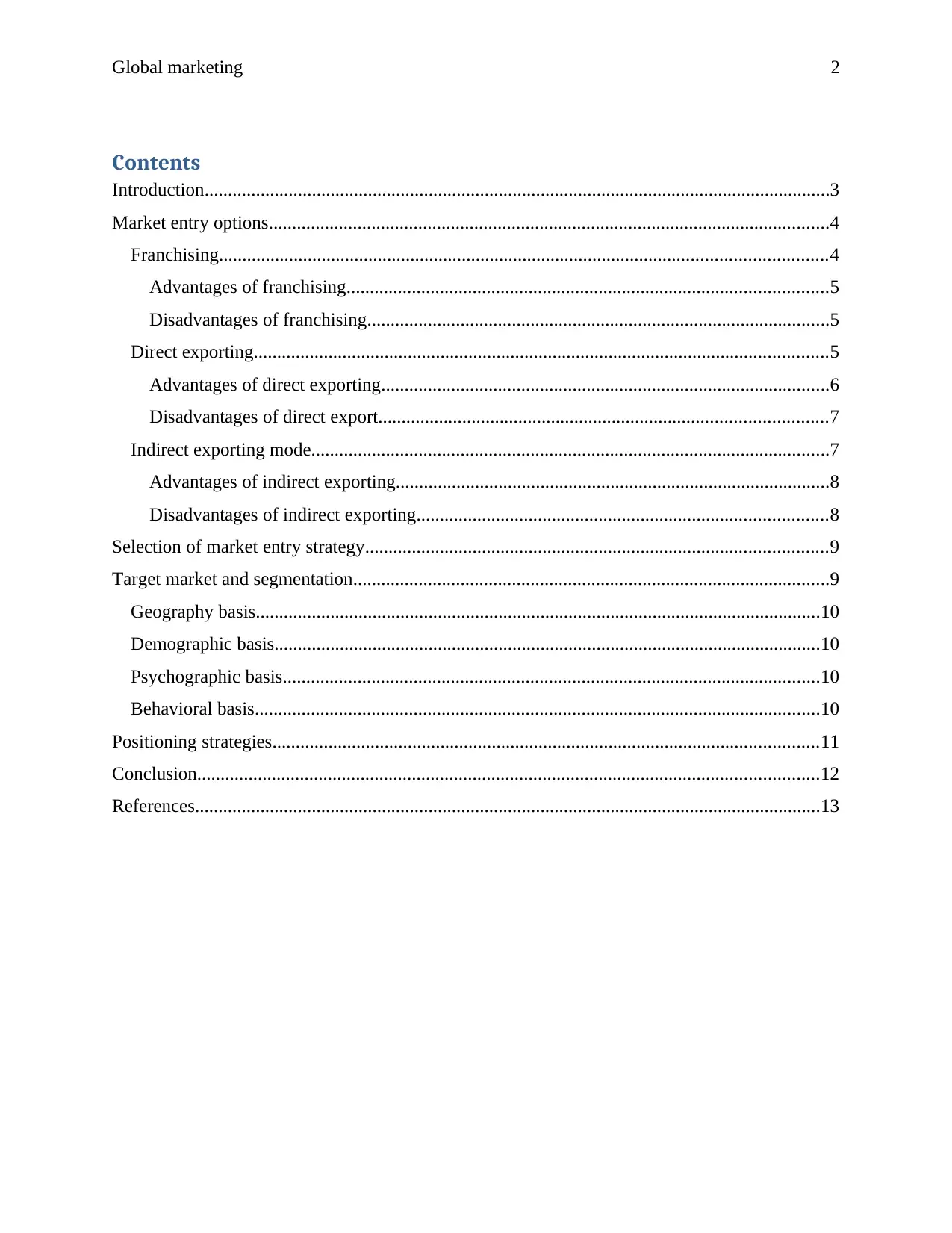
Global marketing 2
Contents
Introduction......................................................................................................................................3
Market entry options........................................................................................................................4
Franchising..................................................................................................................................4
Advantages of franchising.......................................................................................................5
Disadvantages of franchising...................................................................................................5
Direct exporting...........................................................................................................................5
Advantages of direct exporting................................................................................................6
Disadvantages of direct export................................................................................................7
Indirect exporting mode...............................................................................................................7
Advantages of indirect exporting.............................................................................................8
Disadvantages of indirect exporting........................................................................................8
Selection of market entry strategy...................................................................................................9
Target market and segmentation......................................................................................................9
Geography basis.........................................................................................................................10
Demographic basis.....................................................................................................................10
Psychographic basis...................................................................................................................10
Behavioral basis.........................................................................................................................10
Positioning strategies.....................................................................................................................11
Conclusion.....................................................................................................................................12
References......................................................................................................................................13
Contents
Introduction......................................................................................................................................3
Market entry options........................................................................................................................4
Franchising..................................................................................................................................4
Advantages of franchising.......................................................................................................5
Disadvantages of franchising...................................................................................................5
Direct exporting...........................................................................................................................5
Advantages of direct exporting................................................................................................6
Disadvantages of direct export................................................................................................7
Indirect exporting mode...............................................................................................................7
Advantages of indirect exporting.............................................................................................8
Disadvantages of indirect exporting........................................................................................8
Selection of market entry strategy...................................................................................................9
Target market and segmentation......................................................................................................9
Geography basis.........................................................................................................................10
Demographic basis.....................................................................................................................10
Psychographic basis...................................................................................................................10
Behavioral basis.........................................................................................................................10
Positioning strategies.....................................................................................................................11
Conclusion.....................................................................................................................................12
References......................................................................................................................................13
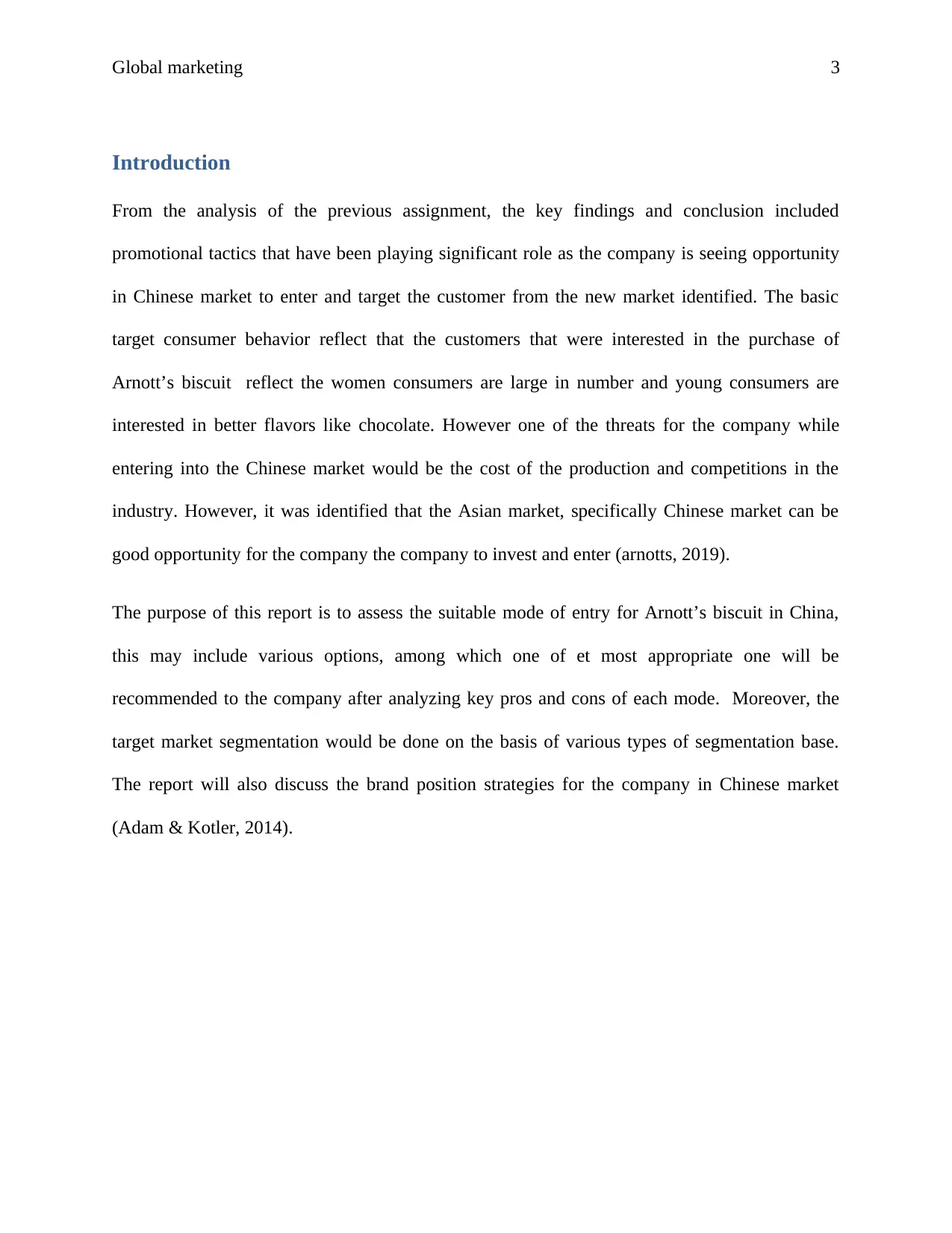
Global marketing 3
Introduction
From the analysis of the previous assignment, the key findings and conclusion included
promotional tactics that have been playing significant role as the company is seeing opportunity
in Chinese market to enter and target the customer from the new market identified. The basic
target consumer behavior reflect that the customers that were interested in the purchase of
Arnott’s biscuit reflect the women consumers are large in number and young consumers are
interested in better flavors like chocolate. However one of the threats for the company while
entering into the Chinese market would be the cost of the production and competitions in the
industry. However, it was identified that the Asian market, specifically Chinese market can be
good opportunity for the company the company to invest and enter (arnotts, 2019).
The purpose of this report is to assess the suitable mode of entry for Arnott’s biscuit in China,
this may include various options, among which one of et most appropriate one will be
recommended to the company after analyzing key pros and cons of each mode. Moreover, the
target market segmentation would be done on the basis of various types of segmentation base.
The report will also discuss the brand position strategies for the company in Chinese market
(Adam & Kotler, 2014).
Introduction
From the analysis of the previous assignment, the key findings and conclusion included
promotional tactics that have been playing significant role as the company is seeing opportunity
in Chinese market to enter and target the customer from the new market identified. The basic
target consumer behavior reflect that the customers that were interested in the purchase of
Arnott’s biscuit reflect the women consumers are large in number and young consumers are
interested in better flavors like chocolate. However one of the threats for the company while
entering into the Chinese market would be the cost of the production and competitions in the
industry. However, it was identified that the Asian market, specifically Chinese market can be
good opportunity for the company the company to invest and enter (arnotts, 2019).
The purpose of this report is to assess the suitable mode of entry for Arnott’s biscuit in China,
this may include various options, among which one of et most appropriate one will be
recommended to the company after analyzing key pros and cons of each mode. Moreover, the
target market segmentation would be done on the basis of various types of segmentation base.
The report will also discuss the brand position strategies for the company in Chinese market
(Adam & Kotler, 2014).
Secure Best Marks with AI Grader
Need help grading? Try our AI Grader for instant feedback on your assignments.
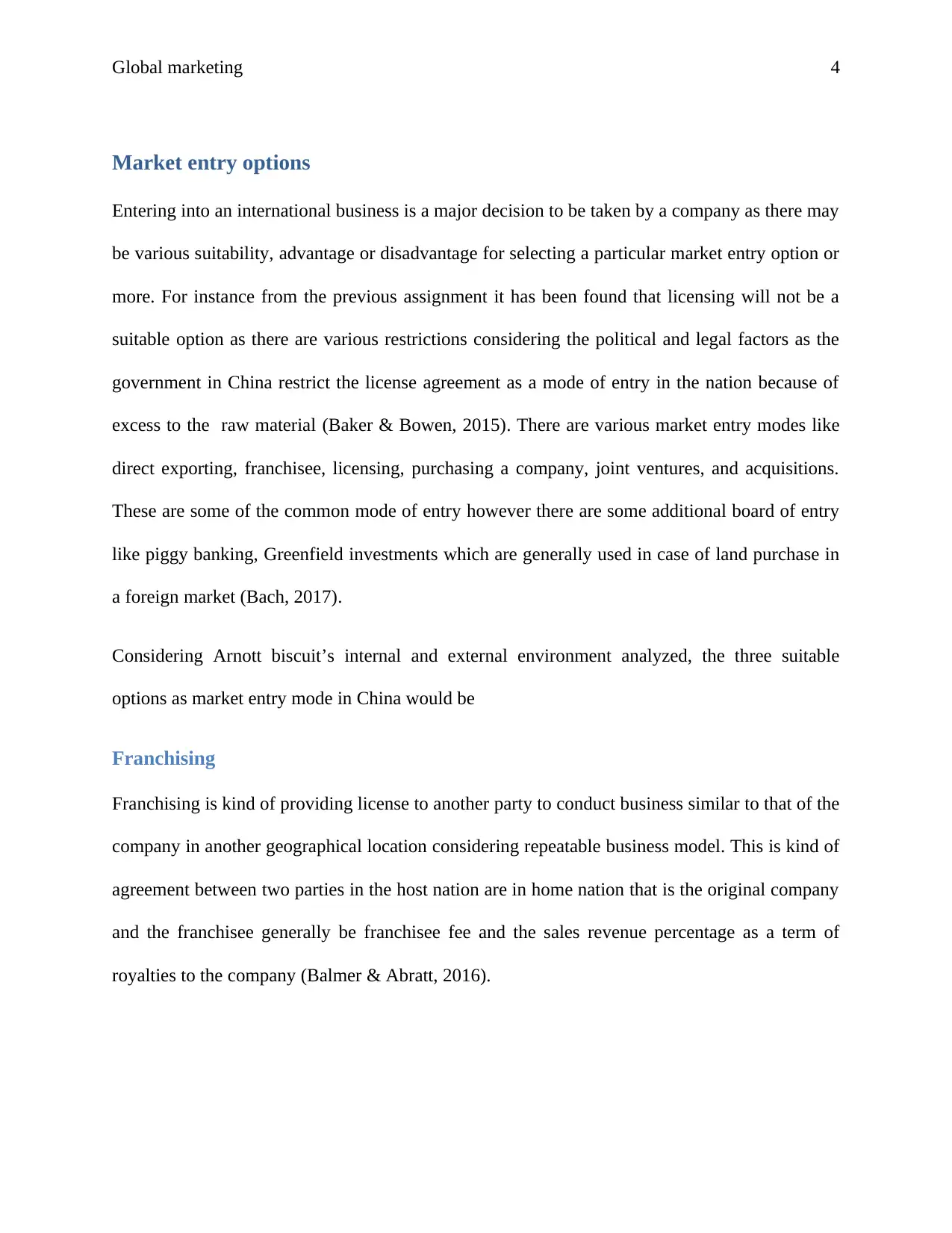
Global marketing 4
Market entry options
Entering into an international business is a major decision to be taken by a company as there may
be various suitability, advantage or disadvantage for selecting a particular market entry option or
more. For instance from the previous assignment it has been found that licensing will not be a
suitable option as there are various restrictions considering the political and legal factors as the
government in China restrict the license agreement as a mode of entry in the nation because of
excess to the raw material (Baker & Bowen, 2015). There are various market entry modes like
direct exporting, franchisee, licensing, purchasing a company, joint ventures, and acquisitions.
These are some of the common mode of entry however there are some additional board of entry
like piggy banking, Greenfield investments which are generally used in case of land purchase in
a foreign market (Bach, 2017).
Considering Arnott biscuit’s internal and external environment analyzed, the three suitable
options as market entry mode in China would be
Franchising
Franchising is kind of providing license to another party to conduct business similar to that of the
company in another geographical location considering repeatable business model. This is kind of
agreement between two parties in the host nation are in home nation that is the original company
and the franchisee generally be franchisee fee and the sales revenue percentage as a term of
royalties to the company (Balmer & Abratt, 2016).
Market entry options
Entering into an international business is a major decision to be taken by a company as there may
be various suitability, advantage or disadvantage for selecting a particular market entry option or
more. For instance from the previous assignment it has been found that licensing will not be a
suitable option as there are various restrictions considering the political and legal factors as the
government in China restrict the license agreement as a mode of entry in the nation because of
excess to the raw material (Baker & Bowen, 2015). There are various market entry modes like
direct exporting, franchisee, licensing, purchasing a company, joint ventures, and acquisitions.
These are some of the common mode of entry however there are some additional board of entry
like piggy banking, Greenfield investments which are generally used in case of land purchase in
a foreign market (Bach, 2017).
Considering Arnott biscuit’s internal and external environment analyzed, the three suitable
options as market entry mode in China would be
Franchising
Franchising is kind of providing license to another party to conduct business similar to that of the
company in another geographical location considering repeatable business model. This is kind of
agreement between two parties in the host nation are in home nation that is the original company
and the franchisee generally be franchisee fee and the sales revenue percentage as a term of
royalties to the company (Balmer & Abratt, 2016).
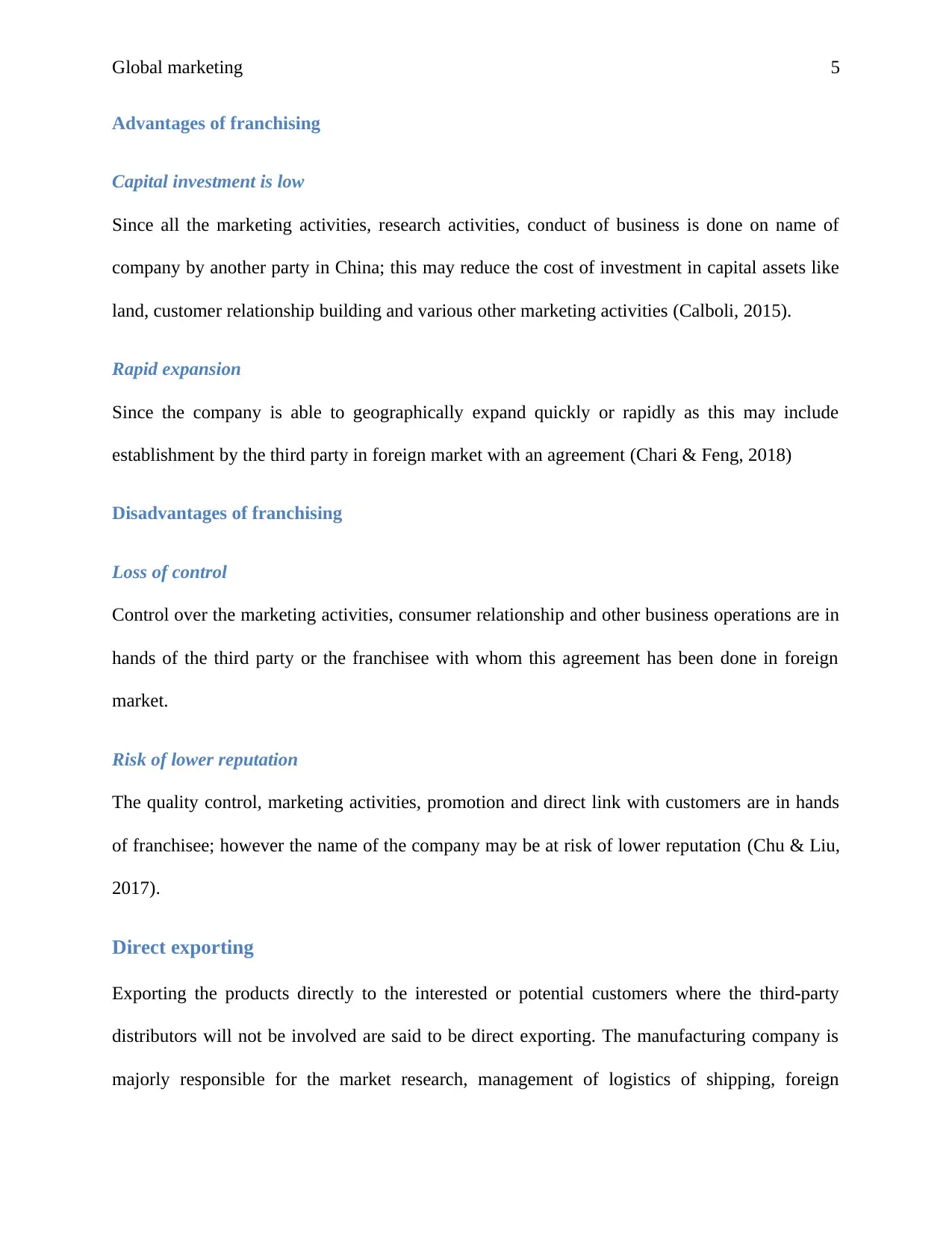
Global marketing 5
Advantages of franchising
Capital investment is low
Since all the marketing activities, research activities, conduct of business is done on name of
company by another party in China; this may reduce the cost of investment in capital assets like
land, customer relationship building and various other marketing activities (Calboli, 2015).
Rapid expansion
Since the company is able to geographically expand quickly or rapidly as this may include
establishment by the third party in foreign market with an agreement (Chari & Feng, 2018)
Disadvantages of franchising
Loss of control
Control over the marketing activities, consumer relationship and other business operations are in
hands of the third party or the franchisee with whom this agreement has been done in foreign
market.
Risk of lower reputation
The quality control, marketing activities, promotion and direct link with customers are in hands
of franchisee; however the name of the company may be at risk of lower reputation (Chu & Liu,
2017).
Direct exporting
Exporting the products directly to the interested or potential customers where the third-party
distributors will not be involved are said to be direct exporting. The manufacturing company is
majorly responsible for the market research, management of logistics of shipping, foreign
Advantages of franchising
Capital investment is low
Since all the marketing activities, research activities, conduct of business is done on name of
company by another party in China; this may reduce the cost of investment in capital assets like
land, customer relationship building and various other marketing activities (Calboli, 2015).
Rapid expansion
Since the company is able to geographically expand quickly or rapidly as this may include
establishment by the third party in foreign market with an agreement (Chari & Feng, 2018)
Disadvantages of franchising
Loss of control
Control over the marketing activities, consumer relationship and other business operations are in
hands of the third party or the franchisee with whom this agreement has been done in foreign
market.
Risk of lower reputation
The quality control, marketing activities, promotion and direct link with customers are in hands
of franchisee; however the name of the company may be at risk of lower reputation (Chu & Liu,
2017).
Direct exporting
Exporting the products directly to the interested or potential customers where the third-party
distributors will not be involved are said to be direct exporting. The manufacturing company is
majorly responsible for the market research, management of logistics of shipping, foreign
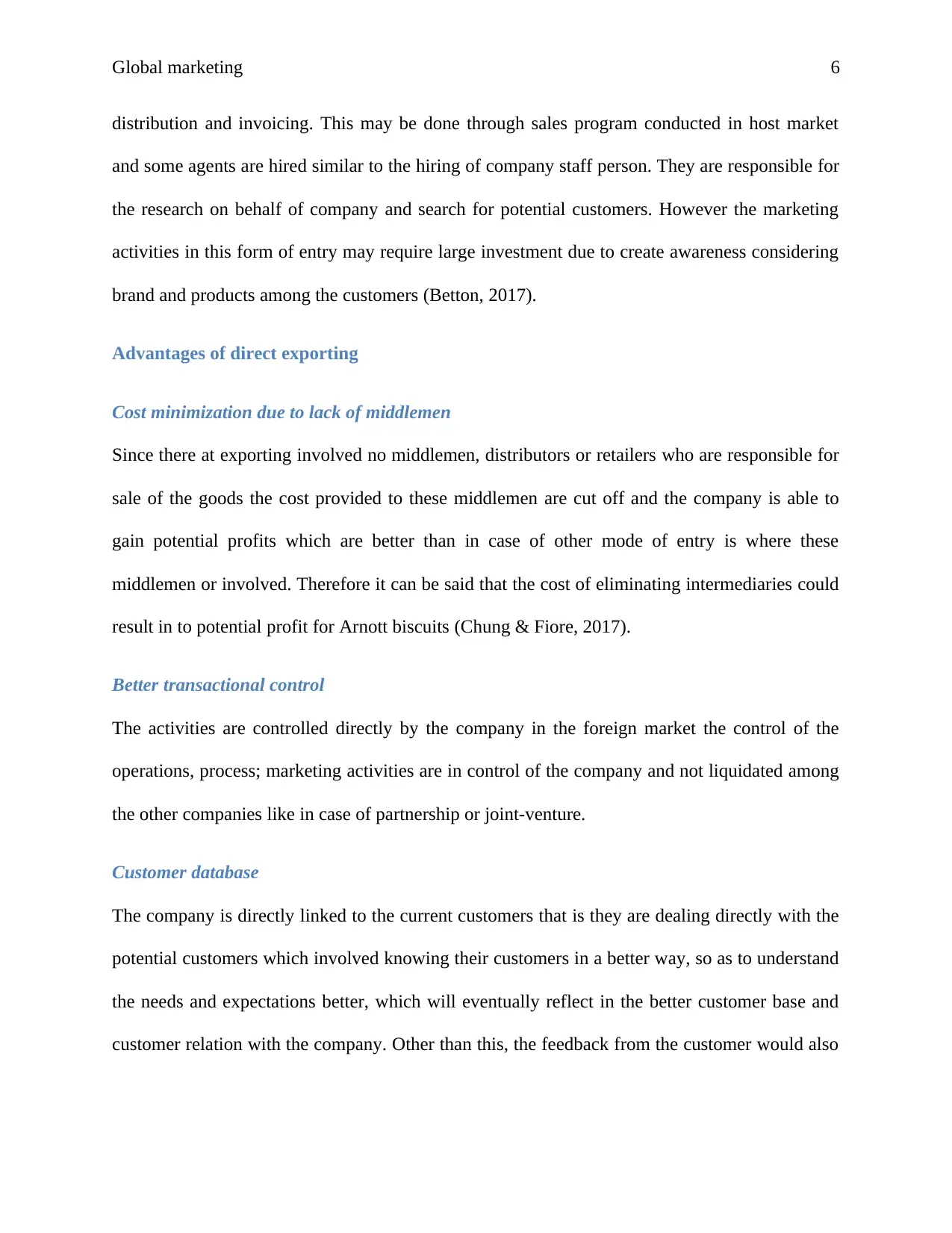
Global marketing 6
distribution and invoicing. This may be done through sales program conducted in host market
and some agents are hired similar to the hiring of company staff person. They are responsible for
the research on behalf of company and search for potential customers. However the marketing
activities in this form of entry may require large investment due to create awareness considering
brand and products among the customers (Betton, 2017).
Advantages of direct exporting
Cost minimization due to lack of middlemen
Since there at exporting involved no middlemen, distributors or retailers who are responsible for
sale of the goods the cost provided to these middlemen are cut off and the company is able to
gain potential profits which are better than in case of other mode of entry is where these
middlemen or involved. Therefore it can be said that the cost of eliminating intermediaries could
result in to potential profit for Arnott biscuits (Chung & Fiore, 2017).
Better transactional control
The activities are controlled directly by the company in the foreign market the control of the
operations, process; marketing activities are in control of the company and not liquidated among
the other companies like in case of partnership or joint-venture.
Customer database
The company is directly linked to the current customers that is they are dealing directly with the
potential customers which involved knowing their customers in a better way, so as to understand
the needs and expectations better, which will eventually reflect in the better customer base and
customer relation with the company. Other than this, the feedback from the customer would also
distribution and invoicing. This may be done through sales program conducted in host market
and some agents are hired similar to the hiring of company staff person. They are responsible for
the research on behalf of company and search for potential customers. However the marketing
activities in this form of entry may require large investment due to create awareness considering
brand and products among the customers (Betton, 2017).
Advantages of direct exporting
Cost minimization due to lack of middlemen
Since there at exporting involved no middlemen, distributors or retailers who are responsible for
sale of the goods the cost provided to these middlemen are cut off and the company is able to
gain potential profits which are better than in case of other mode of entry is where these
middlemen or involved. Therefore it can be said that the cost of eliminating intermediaries could
result in to potential profit for Arnott biscuits (Chung & Fiore, 2017).
Better transactional control
The activities are controlled directly by the company in the foreign market the control of the
operations, process; marketing activities are in control of the company and not liquidated among
the other companies like in case of partnership or joint-venture.
Customer database
The company is directly linked to the current customers that is they are dealing directly with the
potential customers which involved knowing their customers in a better way, so as to understand
the needs and expectations better, which will eventually reflect in the better customer base and
customer relation with the company. Other than this, the feedback from the customer would also
Paraphrase This Document
Need a fresh take? Get an instant paraphrase of this document with our AI Paraphraser
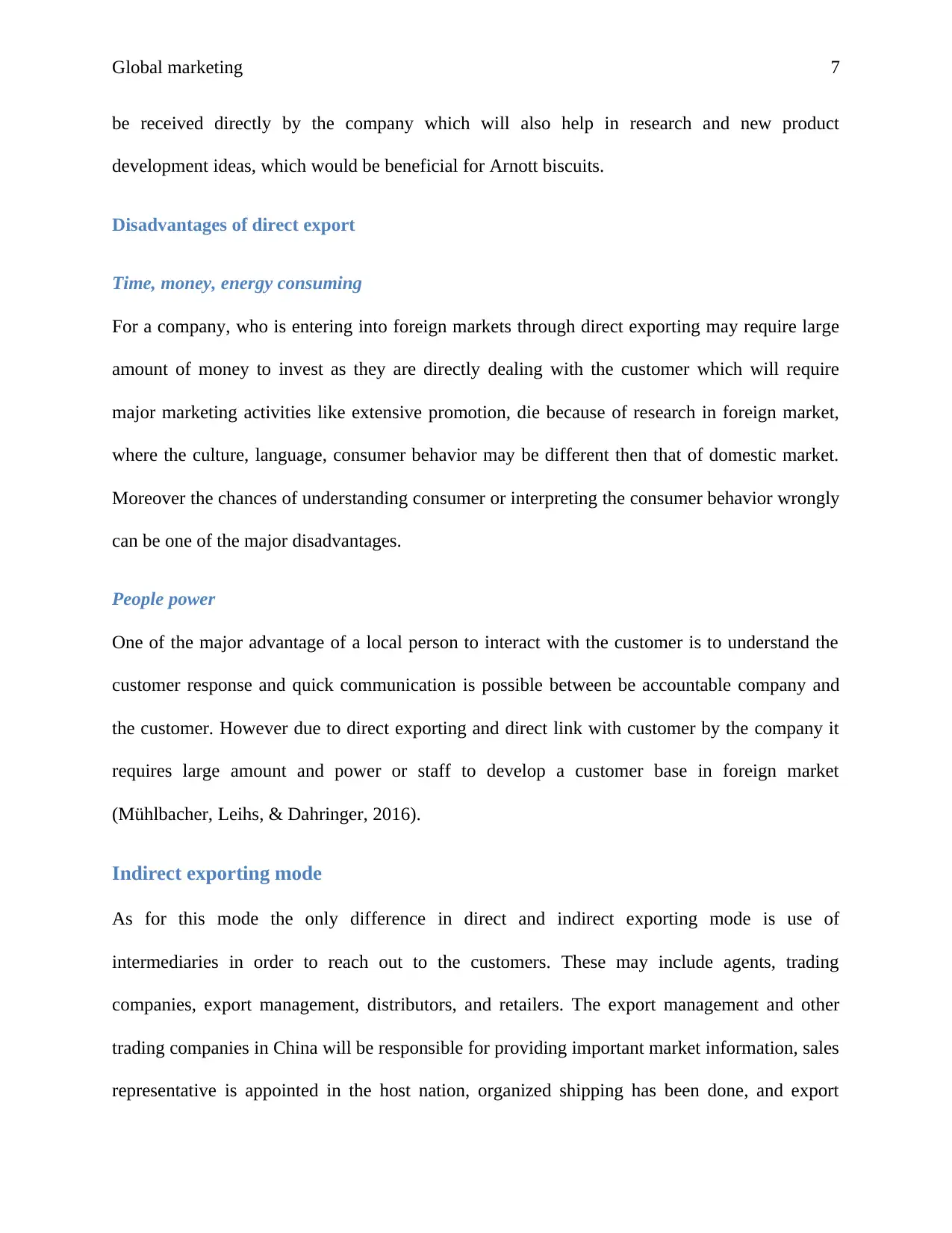
Global marketing 7
be received directly by the company which will also help in research and new product
development ideas, which would be beneficial for Arnott biscuits.
Disadvantages of direct export
Time, money, energy consuming
For a company, who is entering into foreign markets through direct exporting may require large
amount of money to invest as they are directly dealing with the customer which will require
major marketing activities like extensive promotion, die because of research in foreign market,
where the culture, language, consumer behavior may be different then that of domestic market.
Moreover the chances of understanding consumer or interpreting the consumer behavior wrongly
can be one of the major disadvantages.
People power
One of the major advantage of a local person to interact with the customer is to understand the
customer response and quick communication is possible between be accountable company and
the customer. However due to direct exporting and direct link with customer by the company it
requires large amount and power or staff to develop a customer base in foreign market
(Mühlbacher, Leihs, & Dahringer, 2016).
Indirect exporting mode
As for this mode the only difference in direct and indirect exporting mode is use of
intermediaries in order to reach out to the customers. These may include agents, trading
companies, export management, distributors, and retailers. The export management and other
trading companies in China will be responsible for providing important market information, sales
representative is appointed in the host nation, organized shipping has been done, and export
be received directly by the company which will also help in research and new product
development ideas, which would be beneficial for Arnott biscuits.
Disadvantages of direct export
Time, money, energy consuming
For a company, who is entering into foreign markets through direct exporting may require large
amount of money to invest as they are directly dealing with the customer which will require
major marketing activities like extensive promotion, die because of research in foreign market,
where the culture, language, consumer behavior may be different then that of domestic market.
Moreover the chances of understanding consumer or interpreting the consumer behavior wrongly
can be one of the major disadvantages.
People power
One of the major advantage of a local person to interact with the customer is to understand the
customer response and quick communication is possible between be accountable company and
the customer. However due to direct exporting and direct link with customer by the company it
requires large amount and power or staff to develop a customer base in foreign market
(Mühlbacher, Leihs, & Dahringer, 2016).
Indirect exporting mode
As for this mode the only difference in direct and indirect exporting mode is use of
intermediaries in order to reach out to the customers. These may include agents, trading
companies, export management, distributors, and retailers. The export management and other
trading companies in China will be responsible for providing important market information, sales
representative is appointed in the host nation, organized shipping has been done, and export
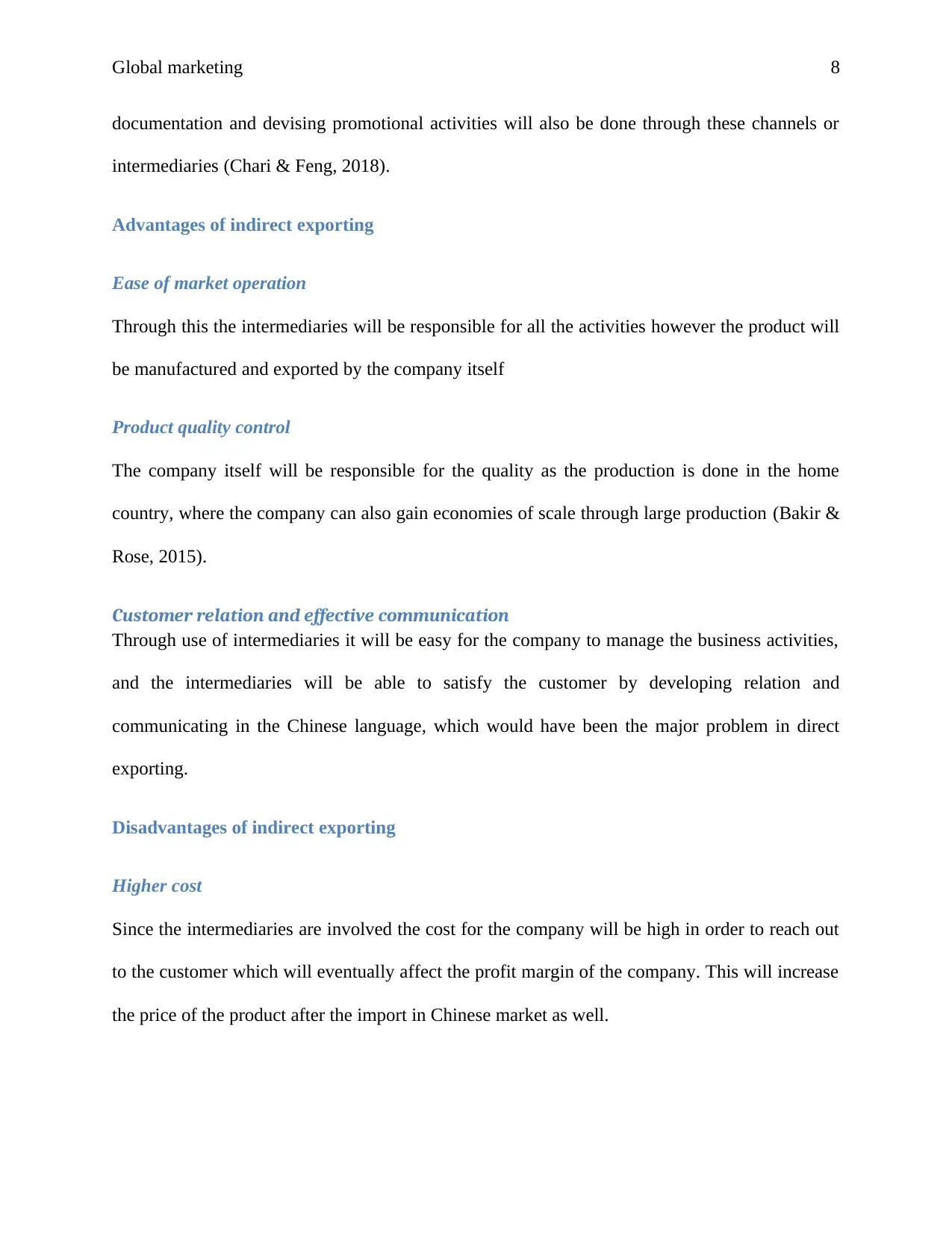
Global marketing 8
documentation and devising promotional activities will also be done through these channels or
intermediaries (Chari & Feng, 2018).
Advantages of indirect exporting
Ease of market operation
Through this the intermediaries will be responsible for all the activities however the product will
be manufactured and exported by the company itself
Product quality control
The company itself will be responsible for the quality as the production is done in the home
country, where the company can also gain economies of scale through large production (Bakir &
Rose, 2015).
Customer relation and effective communication
Through use of intermediaries it will be easy for the company to manage the business activities,
and the intermediaries will be able to satisfy the customer by developing relation and
communicating in the Chinese language, which would have been the major problem in direct
exporting.
Disadvantages of indirect exporting
Higher cost
Since the intermediaries are involved the cost for the company will be high in order to reach out
to the customer which will eventually affect the profit margin of the company. This will increase
the price of the product after the import in Chinese market as well.
documentation and devising promotional activities will also be done through these channels or
intermediaries (Chari & Feng, 2018).
Advantages of indirect exporting
Ease of market operation
Through this the intermediaries will be responsible for all the activities however the product will
be manufactured and exported by the company itself
Product quality control
The company itself will be responsible for the quality as the production is done in the home
country, where the company can also gain economies of scale through large production (Bakir &
Rose, 2015).
Customer relation and effective communication
Through use of intermediaries it will be easy for the company to manage the business activities,
and the intermediaries will be able to satisfy the customer by developing relation and
communicating in the Chinese language, which would have been the major problem in direct
exporting.
Disadvantages of indirect exporting
Higher cost
Since the intermediaries are involved the cost for the company will be high in order to reach out
to the customer which will eventually affect the profit margin of the company. This will increase
the price of the product after the import in Chinese market as well.
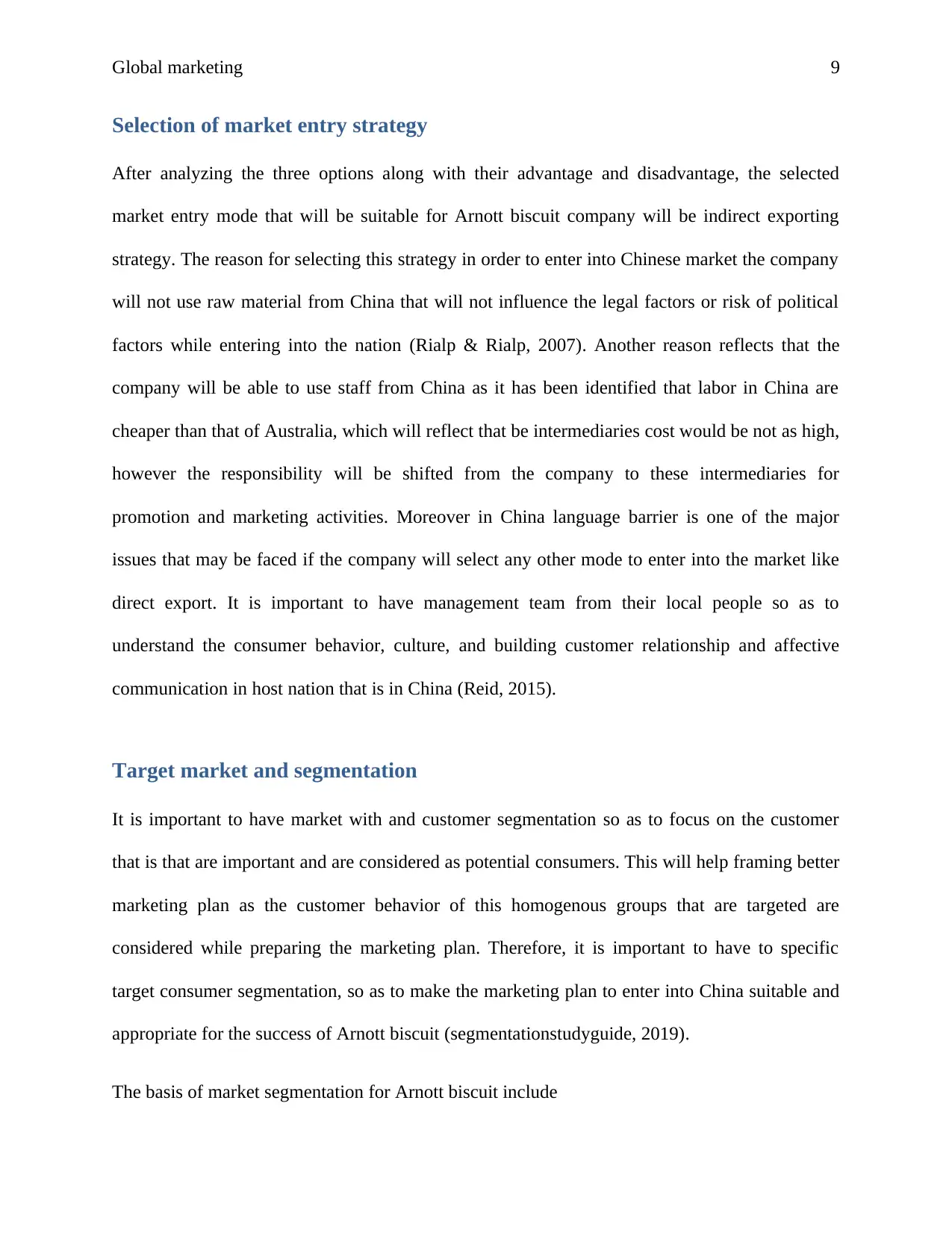
Global marketing 9
Selection of market entry strategy
After analyzing the three options along with their advantage and disadvantage, the selected
market entry mode that will be suitable for Arnott biscuit company will be indirect exporting
strategy. The reason for selecting this strategy in order to enter into Chinese market the company
will not use raw material from China that will not influence the legal factors or risk of political
factors while entering into the nation (Rialp & Rialp, 2007). Another reason reflects that the
company will be able to use staff from China as it has been identified that labor in China are
cheaper than that of Australia, which will reflect that be intermediaries cost would be not as high,
however the responsibility will be shifted from the company to these intermediaries for
promotion and marketing activities. Moreover in China language barrier is one of the major
issues that may be faced if the company will select any other mode to enter into the market like
direct export. It is important to have management team from their local people so as to
understand the consumer behavior, culture, and building customer relationship and affective
communication in host nation that is in China (Reid, 2015).
Target market and segmentation
It is important to have market with and customer segmentation so as to focus on the customer
that is that are important and are considered as potential consumers. This will help framing better
marketing plan as the customer behavior of this homogenous groups that are targeted are
considered while preparing the marketing plan. Therefore, it is important to have to specific
target consumer segmentation, so as to make the marketing plan to enter into China suitable and
appropriate for the success of Arnott biscuit (segmentationstudyguide, 2019).
The basis of market segmentation for Arnott biscuit include
Selection of market entry strategy
After analyzing the three options along with their advantage and disadvantage, the selected
market entry mode that will be suitable for Arnott biscuit company will be indirect exporting
strategy. The reason for selecting this strategy in order to enter into Chinese market the company
will not use raw material from China that will not influence the legal factors or risk of political
factors while entering into the nation (Rialp & Rialp, 2007). Another reason reflects that the
company will be able to use staff from China as it has been identified that labor in China are
cheaper than that of Australia, which will reflect that be intermediaries cost would be not as high,
however the responsibility will be shifted from the company to these intermediaries for
promotion and marketing activities. Moreover in China language barrier is one of the major
issues that may be faced if the company will select any other mode to enter into the market like
direct export. It is important to have management team from their local people so as to
understand the consumer behavior, culture, and building customer relationship and affective
communication in host nation that is in China (Reid, 2015).
Target market and segmentation
It is important to have market with and customer segmentation so as to focus on the customer
that is that are important and are considered as potential consumers. This will help framing better
marketing plan as the customer behavior of this homogenous groups that are targeted are
considered while preparing the marketing plan. Therefore, it is important to have to specific
target consumer segmentation, so as to make the marketing plan to enter into China suitable and
appropriate for the success of Arnott biscuit (segmentationstudyguide, 2019).
The basis of market segmentation for Arnott biscuit include
Secure Best Marks with AI Grader
Need help grading? Try our AI Grader for instant feedback on your assignments.
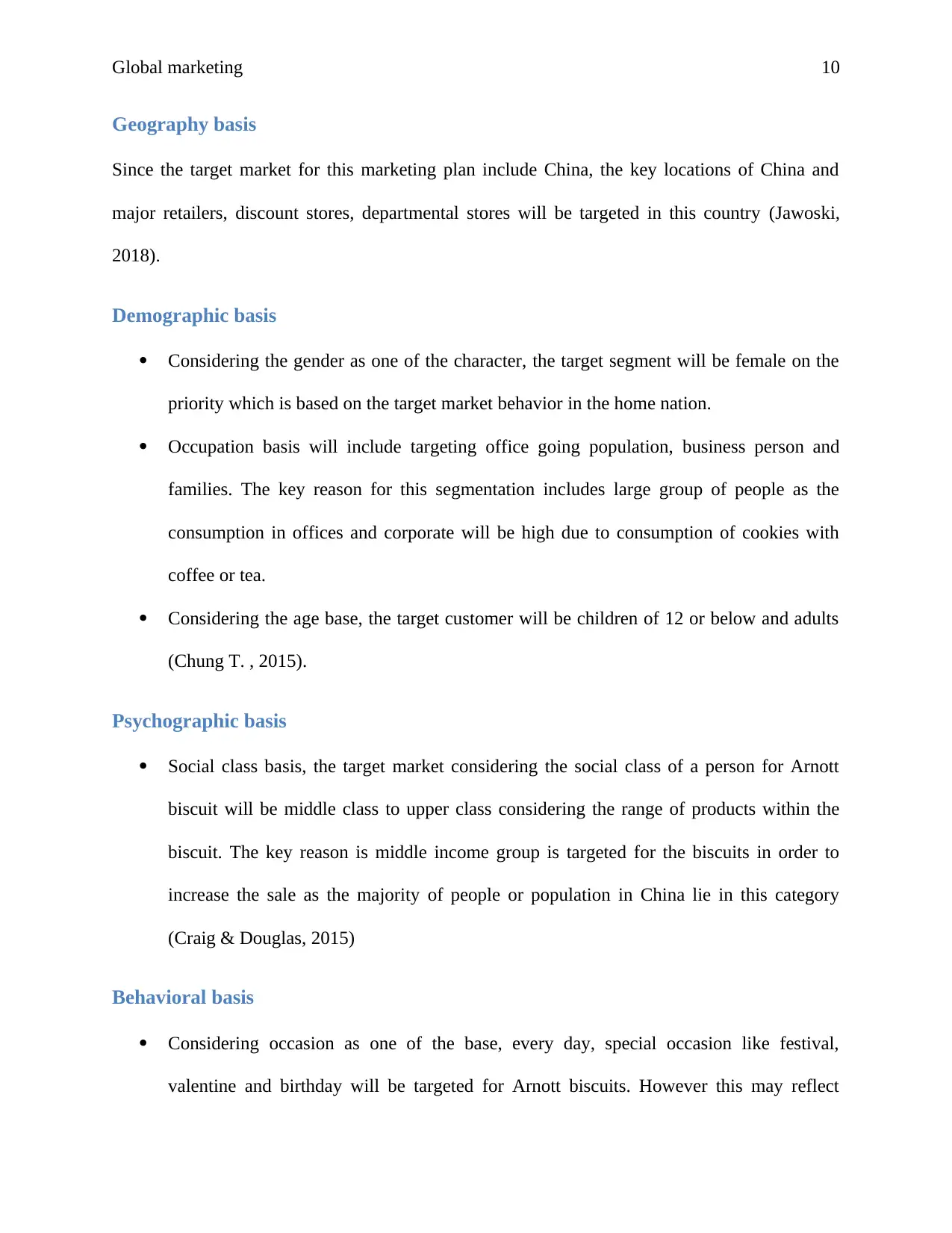
Global marketing 10
Geography basis
Since the target market for this marketing plan include China, the key locations of China and
major retailers, discount stores, departmental stores will be targeted in this country (Jawoski,
2018).
Demographic basis
Considering the gender as one of the character, the target segment will be female on the
priority which is based on the target market behavior in the home nation.
Occupation basis will include targeting office going population, business person and
families. The key reason for this segmentation includes large group of people as the
consumption in offices and corporate will be high due to consumption of cookies with
coffee or tea.
Considering the age base, the target customer will be children of 12 or below and adults
(Chung T. , 2015).
Psychographic basis
Social class basis, the target market considering the social class of a person for Arnott
biscuit will be middle class to upper class considering the range of products within the
biscuit. The key reason is middle income group is targeted for the biscuits in order to
increase the sale as the majority of people or population in China lie in this category
(Craig & Douglas, 2015)
Behavioral basis
Considering occasion as one of the base, every day, special occasion like festival,
valentine and birthday will be targeted for Arnott biscuits. However this may reflect
Geography basis
Since the target market for this marketing plan include China, the key locations of China and
major retailers, discount stores, departmental stores will be targeted in this country (Jawoski,
2018).
Demographic basis
Considering the gender as one of the character, the target segment will be female on the
priority which is based on the target market behavior in the home nation.
Occupation basis will include targeting office going population, business person and
families. The key reason for this segmentation includes large group of people as the
consumption in offices and corporate will be high due to consumption of cookies with
coffee or tea.
Considering the age base, the target customer will be children of 12 or below and adults
(Chung T. , 2015).
Psychographic basis
Social class basis, the target market considering the social class of a person for Arnott
biscuit will be middle class to upper class considering the range of products within the
biscuit. The key reason is middle income group is targeted for the biscuits in order to
increase the sale as the majority of people or population in China lie in this category
(Craig & Douglas, 2015)
Behavioral basis
Considering occasion as one of the base, every day, special occasion like festival,
valentine and birthday will be targeted for Arnott biscuits. However this may reflect
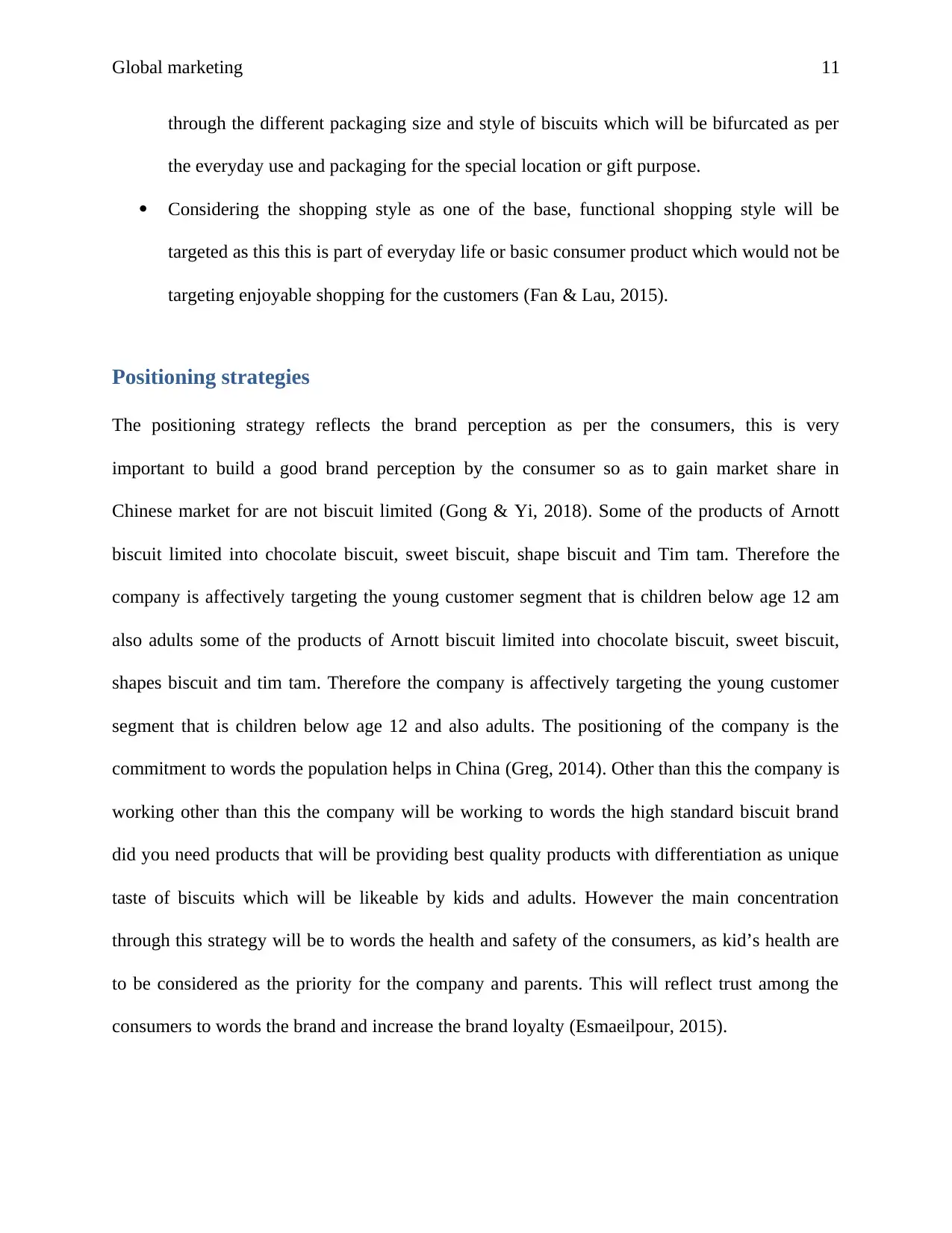
Global marketing 11
through the different packaging size and style of biscuits which will be bifurcated as per
the everyday use and packaging for the special location or gift purpose.
Considering the shopping style as one of the base, functional shopping style will be
targeted as this this is part of everyday life or basic consumer product which would not be
targeting enjoyable shopping for the customers (Fan & Lau, 2015).
Positioning strategies
The positioning strategy reflects the brand perception as per the consumers, this is very
important to build a good brand perception by the consumer so as to gain market share in
Chinese market for are not biscuit limited (Gong & Yi, 2018). Some of the products of Arnott
biscuit limited into chocolate biscuit, sweet biscuit, shape biscuit and Tim tam. Therefore the
company is affectively targeting the young customer segment that is children below age 12 am
also adults some of the products of Arnott biscuit limited into chocolate biscuit, sweet biscuit,
shapes biscuit and tim tam. Therefore the company is affectively targeting the young customer
segment that is children below age 12 and also adults. The positioning of the company is the
commitment to words the population helps in China (Greg, 2014). Other than this the company is
working other than this the company will be working to words the high standard biscuit brand
did you need products that will be providing best quality products with differentiation as unique
taste of biscuits which will be likeable by kids and adults. However the main concentration
through this strategy will be to words the health and safety of the consumers, as kid’s health are
to be considered as the priority for the company and parents. This will reflect trust among the
consumers to words the brand and increase the brand loyalty (Esmaeilpour, 2015).
through the different packaging size and style of biscuits which will be bifurcated as per
the everyday use and packaging for the special location or gift purpose.
Considering the shopping style as one of the base, functional shopping style will be
targeted as this this is part of everyday life or basic consumer product which would not be
targeting enjoyable shopping for the customers (Fan & Lau, 2015).
Positioning strategies
The positioning strategy reflects the brand perception as per the consumers, this is very
important to build a good brand perception by the consumer so as to gain market share in
Chinese market for are not biscuit limited (Gong & Yi, 2018). Some of the products of Arnott
biscuit limited into chocolate biscuit, sweet biscuit, shape biscuit and Tim tam. Therefore the
company is affectively targeting the young customer segment that is children below age 12 am
also adults some of the products of Arnott biscuit limited into chocolate biscuit, sweet biscuit,
shapes biscuit and tim tam. Therefore the company is affectively targeting the young customer
segment that is children below age 12 and also adults. The positioning of the company is the
commitment to words the population helps in China (Greg, 2014). Other than this the company is
working other than this the company will be working to words the high standard biscuit brand
did you need products that will be providing best quality products with differentiation as unique
taste of biscuits which will be likeable by kids and adults. However the main concentration
through this strategy will be to words the health and safety of the consumers, as kid’s health are
to be considered as the priority for the company and parents. This will reflect trust among the
consumers to words the brand and increase the brand loyalty (Esmaeilpour, 2015).
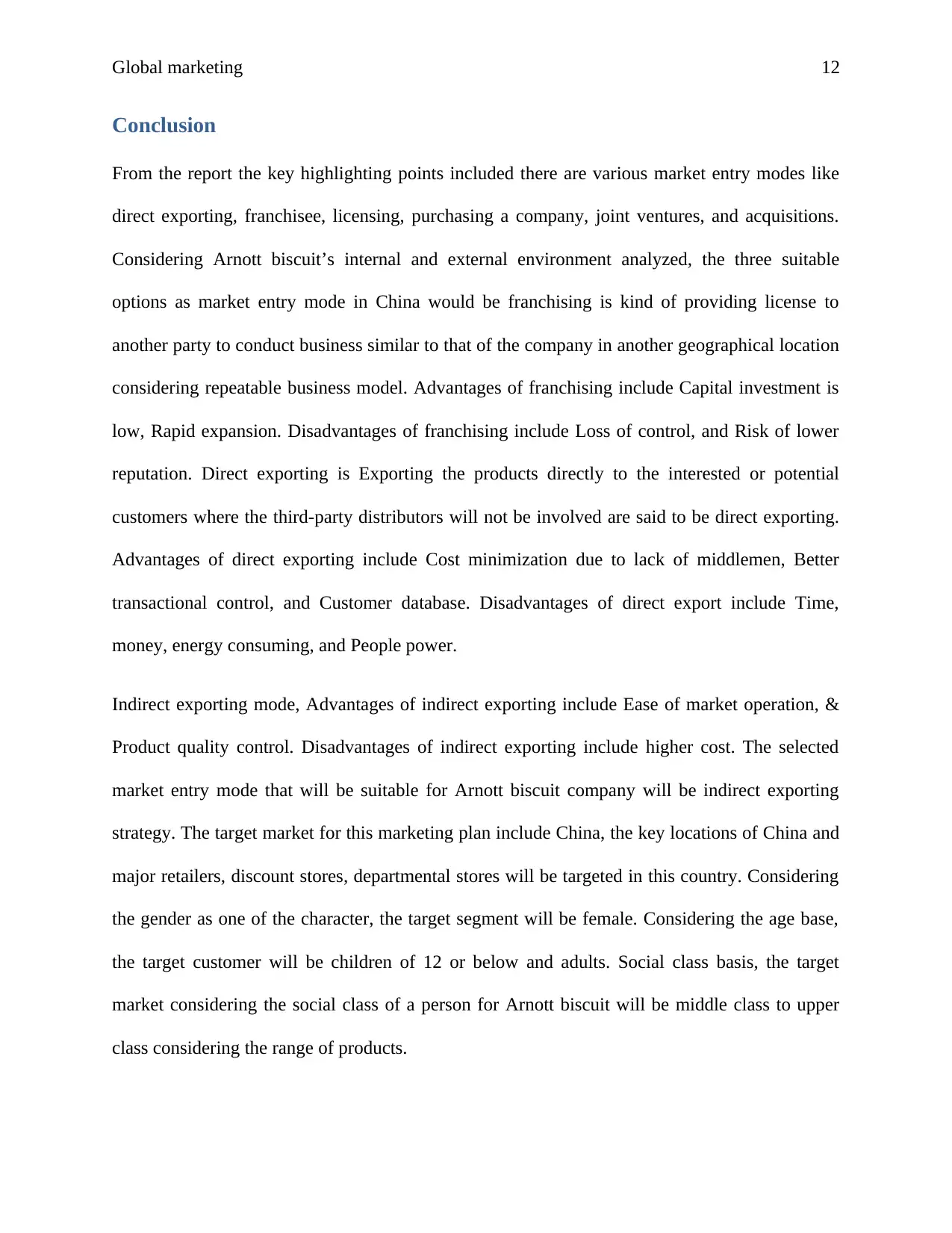
Global marketing 12
Conclusion
From the report the key highlighting points included there are various market entry modes like
direct exporting, franchisee, licensing, purchasing a company, joint ventures, and acquisitions.
Considering Arnott biscuit’s internal and external environment analyzed, the three suitable
options as market entry mode in China would be franchising is kind of providing license to
another party to conduct business similar to that of the company in another geographical location
considering repeatable business model. Advantages of franchising include Capital investment is
low, Rapid expansion. Disadvantages of franchising include Loss of control, and Risk of lower
reputation. Direct exporting is Exporting the products directly to the interested or potential
customers where the third-party distributors will not be involved are said to be direct exporting.
Advantages of direct exporting include Cost minimization due to lack of middlemen, Better
transactional control, and Customer database. Disadvantages of direct export include Time,
money, energy consuming, and People power.
Indirect exporting mode, Advantages of indirect exporting include Ease of market operation, &
Product quality control. Disadvantages of indirect exporting include higher cost. The selected
market entry mode that will be suitable for Arnott biscuit company will be indirect exporting
strategy. The target market for this marketing plan include China, the key locations of China and
major retailers, discount stores, departmental stores will be targeted in this country. Considering
the gender as one of the character, the target segment will be female. Considering the age base,
the target customer will be children of 12 or below and adults. Social class basis, the target
market considering the social class of a person for Arnott biscuit will be middle class to upper
class considering the range of products.
Conclusion
From the report the key highlighting points included there are various market entry modes like
direct exporting, franchisee, licensing, purchasing a company, joint ventures, and acquisitions.
Considering Arnott biscuit’s internal and external environment analyzed, the three suitable
options as market entry mode in China would be franchising is kind of providing license to
another party to conduct business similar to that of the company in another geographical location
considering repeatable business model. Advantages of franchising include Capital investment is
low, Rapid expansion. Disadvantages of franchising include Loss of control, and Risk of lower
reputation. Direct exporting is Exporting the products directly to the interested or potential
customers where the third-party distributors will not be involved are said to be direct exporting.
Advantages of direct exporting include Cost minimization due to lack of middlemen, Better
transactional control, and Customer database. Disadvantages of direct export include Time,
money, energy consuming, and People power.
Indirect exporting mode, Advantages of indirect exporting include Ease of market operation, &
Product quality control. Disadvantages of indirect exporting include higher cost. The selected
market entry mode that will be suitable for Arnott biscuit company will be indirect exporting
strategy. The target market for this marketing plan include China, the key locations of China and
major retailers, discount stores, departmental stores will be targeted in this country. Considering
the gender as one of the character, the target segment will be female. Considering the age base,
the target customer will be children of 12 or below and adults. Social class basis, the target
market considering the social class of a person for Arnott biscuit will be middle class to upper
class considering the range of products.
Paraphrase This Document
Need a fresh take? Get an instant paraphrase of this document with our AI Paraphraser
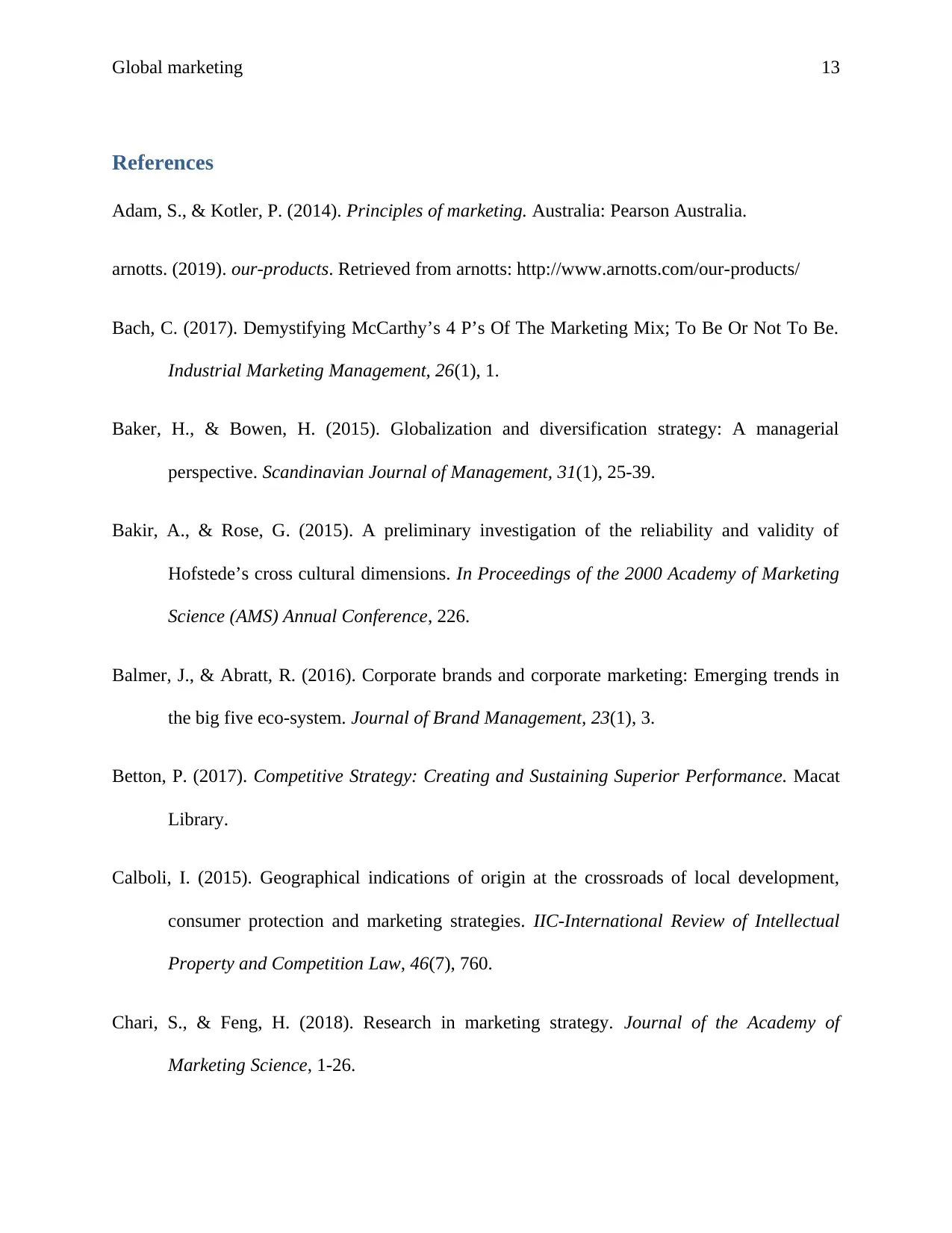
Global marketing 13
References
Adam, S., & Kotler, P. (2014). Principles of marketing. Australia: Pearson Australia.
arnotts. (2019). our-products. Retrieved from arnotts: http://www.arnotts.com/our-products/
Bach, C. (2017). Demystifying McCarthy’s 4 P’s Of The Marketing Mix; To Be Or Not To Be.
Industrial Marketing Management, 26(1), 1.
Baker, H., & Bowen, H. (2015). Globalization and diversification strategy: A managerial
perspective. Scandinavian Journal of Management, 31(1), 25-39.
Bakir, A., & Rose, G. (2015). A preliminary investigation of the reliability and validity of
Hofstede’s cross cultural dimensions. In Proceedings of the 2000 Academy of Marketing
Science (AMS) Annual Conference, 226.
Balmer, J., & Abratt, R. (2016). Corporate brands and corporate marketing: Emerging trends in
the big five eco-system. Journal of Brand Management, 23(1), 3.
Betton, P. (2017). Competitive Strategy: Creating and Sustaining Superior Performance. Macat
Library.
Calboli, I. (2015). Geographical indications of origin at the crossroads of local development,
consumer protection and marketing strategies. IIC-International Review of Intellectual
Property and Competition Law, 46(7), 760.
Chari, S., & Feng, H. (2018). Research in marketing strategy. Journal of the Academy of
Marketing Science, 1-26.
References
Adam, S., & Kotler, P. (2014). Principles of marketing. Australia: Pearson Australia.
arnotts. (2019). our-products. Retrieved from arnotts: http://www.arnotts.com/our-products/
Bach, C. (2017). Demystifying McCarthy’s 4 P’s Of The Marketing Mix; To Be Or Not To Be.
Industrial Marketing Management, 26(1), 1.
Baker, H., & Bowen, H. (2015). Globalization and diversification strategy: A managerial
perspective. Scandinavian Journal of Management, 31(1), 25-39.
Bakir, A., & Rose, G. (2015). A preliminary investigation of the reliability and validity of
Hofstede’s cross cultural dimensions. In Proceedings of the 2000 Academy of Marketing
Science (AMS) Annual Conference, 226.
Balmer, J., & Abratt, R. (2016). Corporate brands and corporate marketing: Emerging trends in
the big five eco-system. Journal of Brand Management, 23(1), 3.
Betton, P. (2017). Competitive Strategy: Creating and Sustaining Superior Performance. Macat
Library.
Calboli, I. (2015). Geographical indications of origin at the crossroads of local development,
consumer protection and marketing strategies. IIC-International Review of Intellectual
Property and Competition Law, 46(7), 760.
Chari, S., & Feng, H. (2018). Research in marketing strategy. Journal of the Academy of
Marketing Science, 1-26.
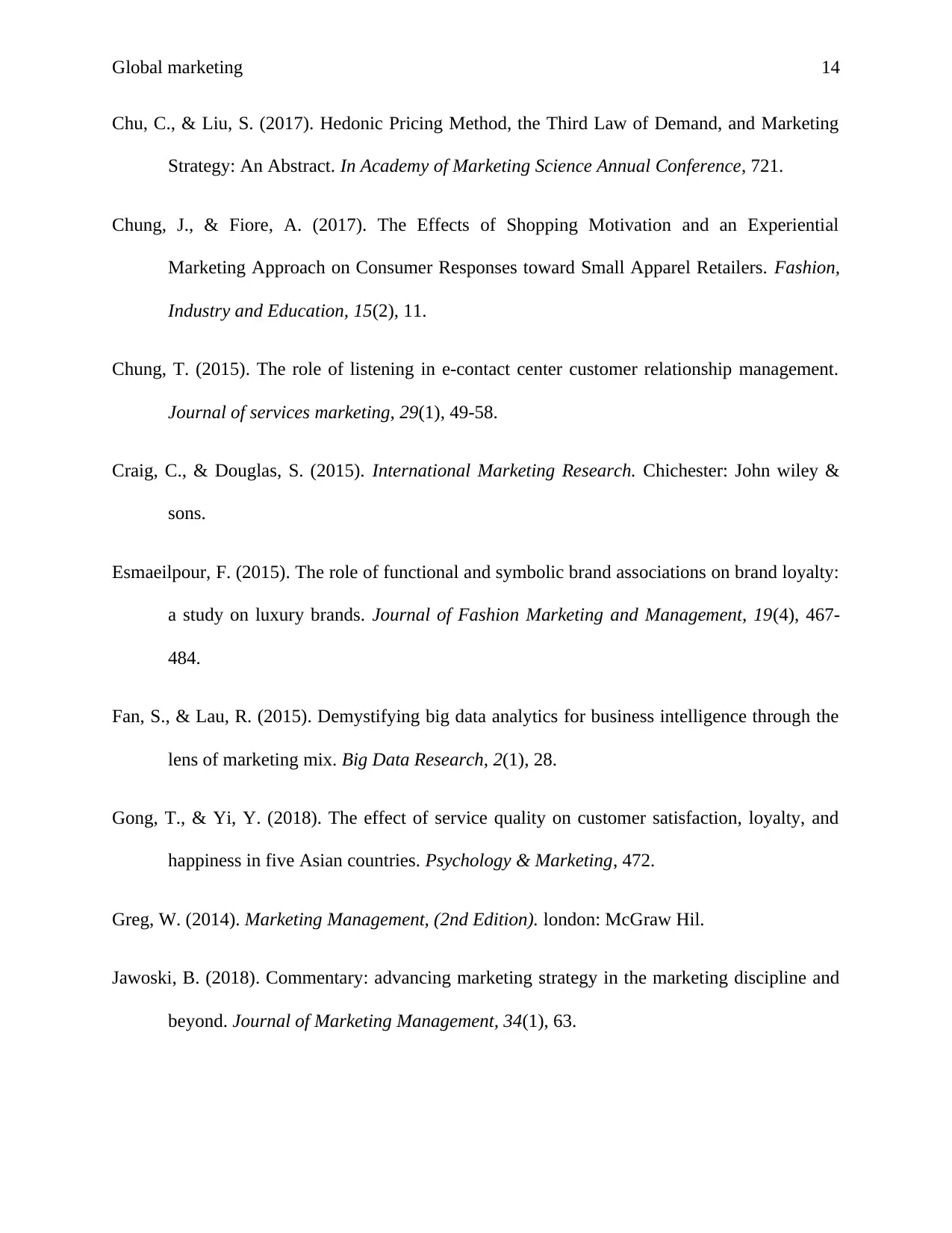
Global marketing 14
Chu, C., & Liu, S. (2017). Hedonic Pricing Method, the Third Law of Demand, and Marketing
Strategy: An Abstract. In Academy of Marketing Science Annual Conference, 721.
Chung, J., & Fiore, A. (2017). The Effects of Shopping Motivation and an Experiential
Marketing Approach on Consumer Responses toward Small Apparel Retailers. Fashion,
Industry and Education, 15(2), 11.
Chung, T. (2015). The role of listening in e-contact center customer relationship management.
Journal of services marketing, 29(1), 49-58.
Craig, C., & Douglas, S. (2015). International Marketing Research. Chichester: John wiley &
sons.
Esmaeilpour, F. (2015). The role of functional and symbolic brand associations on brand loyalty:
a study on luxury brands. Journal of Fashion Marketing and Management, 19(4), 467-
484.
Fan, S., & Lau, R. (2015). Demystifying big data analytics for business intelligence through the
lens of marketing mix. Big Data Research, 2(1), 28.
Gong, T., & Yi, Y. (2018). The effect of service quality on customer satisfaction, loyalty, and
happiness in five Asian countries. Psychology & Marketing, 472.
Greg, W. (2014). Marketing Management, (2nd Edition). london: McGraw Hil.
Jawoski, B. (2018). Commentary: advancing marketing strategy in the marketing discipline and
beyond. Journal of Marketing Management, 34(1), 63.
Chu, C., & Liu, S. (2017). Hedonic Pricing Method, the Third Law of Demand, and Marketing
Strategy: An Abstract. In Academy of Marketing Science Annual Conference, 721.
Chung, J., & Fiore, A. (2017). The Effects of Shopping Motivation and an Experiential
Marketing Approach on Consumer Responses toward Small Apparel Retailers. Fashion,
Industry and Education, 15(2), 11.
Chung, T. (2015). The role of listening in e-contact center customer relationship management.
Journal of services marketing, 29(1), 49-58.
Craig, C., & Douglas, S. (2015). International Marketing Research. Chichester: John wiley &
sons.
Esmaeilpour, F. (2015). The role of functional and symbolic brand associations on brand loyalty:
a study on luxury brands. Journal of Fashion Marketing and Management, 19(4), 467-
484.
Fan, S., & Lau, R. (2015). Demystifying big data analytics for business intelligence through the
lens of marketing mix. Big Data Research, 2(1), 28.
Gong, T., & Yi, Y. (2018). The effect of service quality on customer satisfaction, loyalty, and
happiness in five Asian countries. Psychology & Marketing, 472.
Greg, W. (2014). Marketing Management, (2nd Edition). london: McGraw Hil.
Jawoski, B. (2018). Commentary: advancing marketing strategy in the marketing discipline and
beyond. Journal of Marketing Management, 34(1), 63.
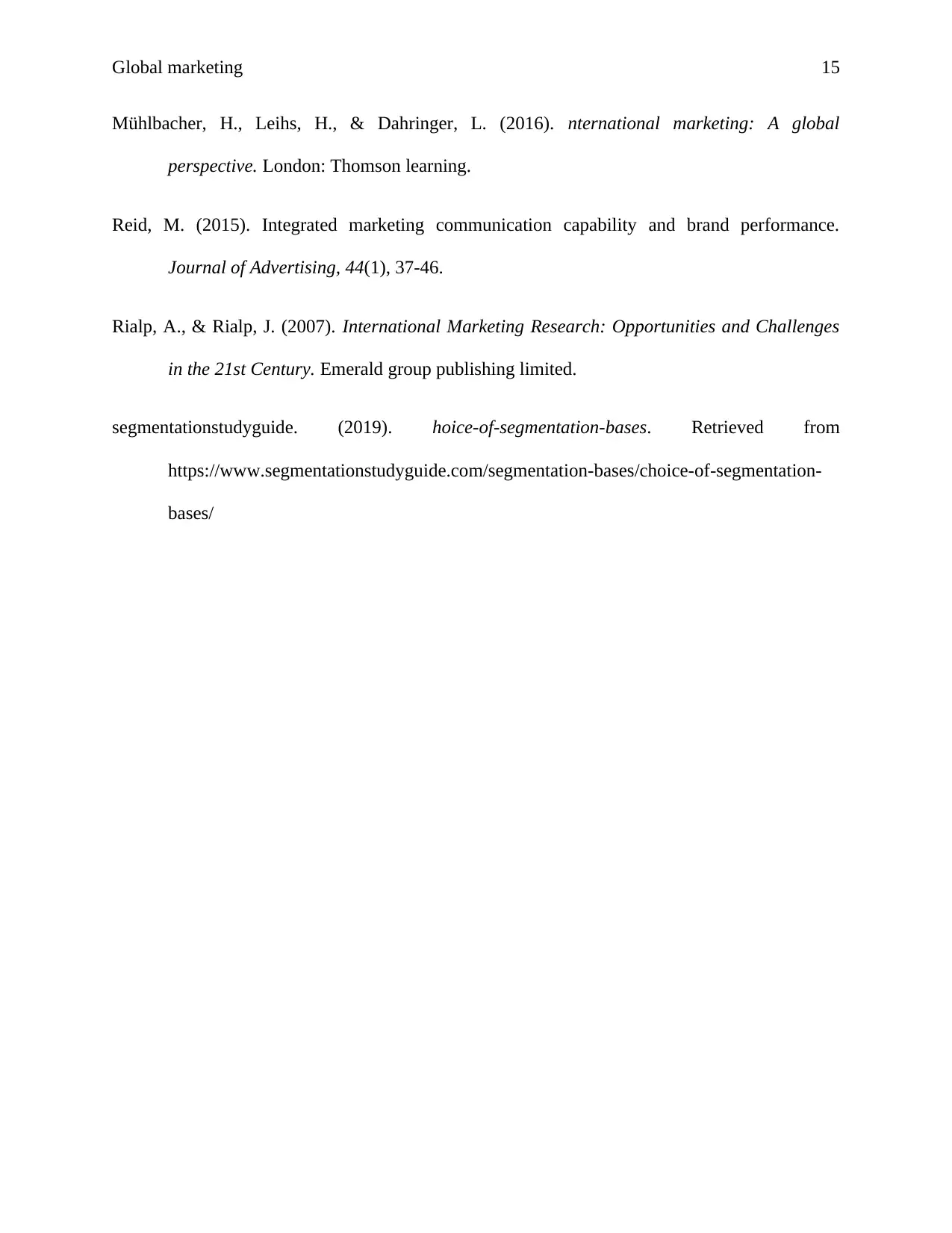
Global marketing 15
Mühlbacher, H., Leihs, H., & Dahringer, L. (2016). nternational marketing: A global
perspective. London: Thomson learning.
Reid, M. (2015). Integrated marketing communication capability and brand performance.
Journal of Advertising, 44(1), 37-46.
Rialp, A., & Rialp, J. (2007). International Marketing Research: Opportunities and Challenges
in the 21st Century. Emerald group publishing limited.
segmentationstudyguide. (2019). hoice-of-segmentation-bases. Retrieved from
https://www.segmentationstudyguide.com/segmentation-bases/choice-of-segmentation-
bases/
Mühlbacher, H., Leihs, H., & Dahringer, L. (2016). nternational marketing: A global
perspective. London: Thomson learning.
Reid, M. (2015). Integrated marketing communication capability and brand performance.
Journal of Advertising, 44(1), 37-46.
Rialp, A., & Rialp, J. (2007). International Marketing Research: Opportunities and Challenges
in the 21st Century. Emerald group publishing limited.
segmentationstudyguide. (2019). hoice-of-segmentation-bases. Retrieved from
https://www.segmentationstudyguide.com/segmentation-bases/choice-of-segmentation-
bases/
1 out of 16
Related Documents
Your All-in-One AI-Powered Toolkit for Academic Success.
+13062052269
info@desklib.com
Available 24*7 on WhatsApp / Email
![[object Object]](/_next/static/media/star-bottom.7253800d.svg)
Unlock your academic potential
© 2024 | Zucol Services PVT LTD | All rights reserved.





